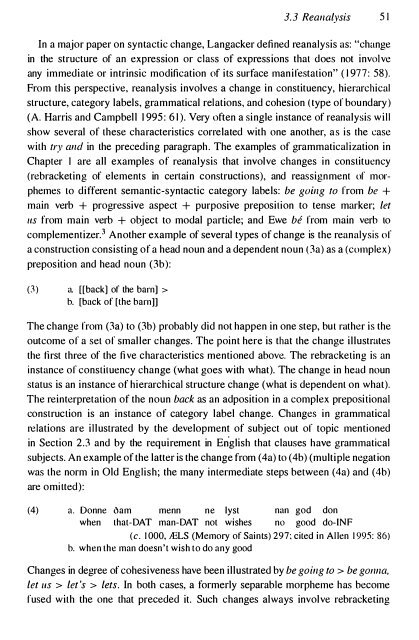Gram - SEAS
Gram - SEAS
Gram - SEAS
Create successful ePaper yourself
Turn your PDF publications into a flip-book with our unique Google optimized e-Paper software.
3. 3 Reanalysis 51<br />
In a major paper on syntactic change, Langacker defined reanalysis as: "change<br />
in the structure of an expression or class of expressions that does not involve<br />
any immediate or intrinsic modification of its surface manifestation" (1977: 58).<br />
From this perspective, reanalysis involves a change in constituency, hierarchical<br />
structure, category labels, grammatical relations, and cohesion (type of boundary )<br />
(A. Harris and Campbell 1995: 61). Very often a single instance of reanalysis will<br />
show several of these characteristics correlated with one another, as is the case<br />
with fry and in the preceding paragraph. The examples of grammaticalization in<br />
Chapter I are all examples of reanalysis that involve changes in constituency<br />
(rebracketing of elements in certain constructions), and reassignment of morphemes<br />
to different semantic-syntactic category labels: be going fo from be +<br />
main verb + progressive aspect + purposive preposition to tense marker; let<br />
liS from main verb + object to modal particle; and Ewe be from main verb to<br />
complementizer. 3 Another example of several types of change is the reanalysis of<br />
a construction consisting of a head noun and a dependent noun (3a) as a (complex)<br />
preposition and head noun (3b):<br />
(3) a. [[back] of the barn] ><br />
b. [back of [the barn]]<br />
The change from (3a) to (3b) probably did not happen in one step, but rather is the<br />
outcome of a set of smaller changes. The point here is that the change illustrates<br />
the first three of the five characteristics mentioned above. The rebracketing is an<br />
instance of constituency change (what goes with what). The change in head noun<br />
status is an instance of hierarchical structure change (what is dependent on what).<br />
The reinterpretation of the noun back as an adposition in a complex prepositional<br />
construction is an instance of category label change. Changes in grammatical<br />
relations are illustrated by the development of subject out of topic mentioned<br />
in Section 2.3 and by the requirement in E n glish that clauses have grammatical<br />
subjects. An example of the latter is the change from (4a) to (4b) (multiple negation<br />
was the norm in Old English; the many intermediate steps between (4a) and (4b)<br />
are omitted):<br />
(4) a. Donne l) am menn ne Iyst nan god don<br />
when that-DAT man-DAT not wishes no good do-INF<br />
(c. 1000, A!LS (Memory of Saints) 297: cited in Allen 1995: 86)<br />
b. when the man doesn't wish to do any good<br />
Changes in degree of cohesiveness have been illustrated by be going to > be gOflna,<br />
let liS > let 's > lets. In both cases, a formerly separable morpheme has become<br />
fused with the one that preceded it. Such changes always involve rebracketing
















